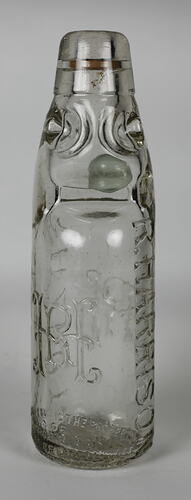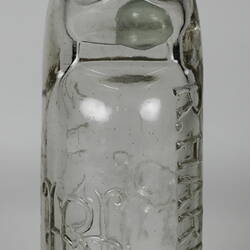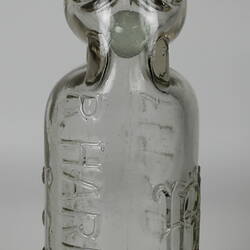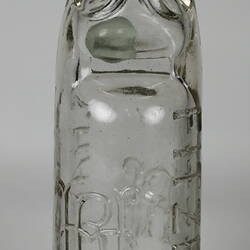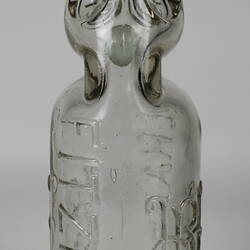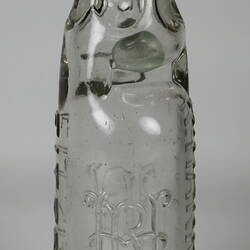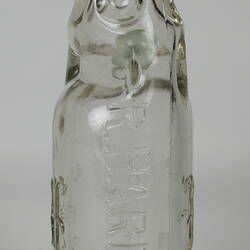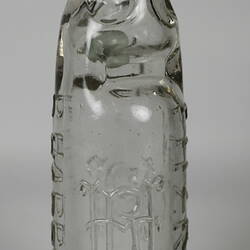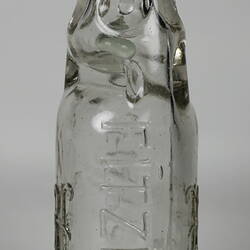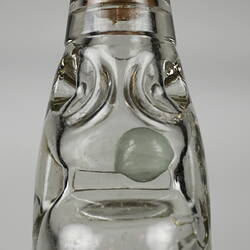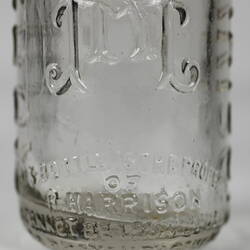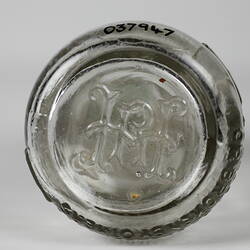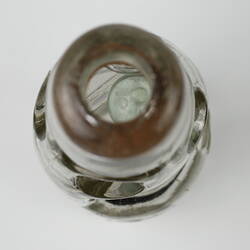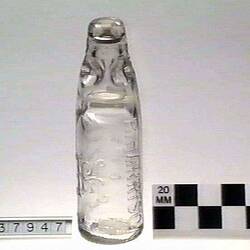Summary
Clear glass bottle with glass marble stopper, inscribed with the name R. Harrison, Fitzroy. It would have contained an aerated water, probably flavoured. The gas in the contents would have pushed up the marble against a rubber (or similar) inside the mouth of the bottle, sealing the contents (Codd-neck). To drink the contents, the user pushed the marble down into the neck of the bottle, where it remained until it was refilled. The bottles were often broken to release the marbles for children to play with - hence the inscription on the bottle 'Cannot be legally ... broken by others'.
R. Harrison (Robert Harrison) Steam Cordial Works, operated a 'Fitrzroy Aerated and Mineral Water Works' from at least 1880 at 8-10 Spring Street, Fitrroy, Melbourne. (The factory on that site today still has a partly obscured sign for R. Harrison Cordial & Aerated Waters.) By 1902 the company was advertising that it sold 'PURE DRINKS. WE GUARANTEE that all our Aerated Waters, namely - LEMONADE. GINGER ALE. SARSAPARILLA. LIMEADE, SODA WATER. LITHIIA WATER [mineral water with lithium salts], SELTZER WATER. TONIC WATER, are made from the very finest and Purest Materials procurable, and are absolutely from from Salicylic Acid, Saccharin, or other deleterious ingredients. ALL WATER FILTERED THROUGH JEFFERY'S GERM-PROOF FILTERS. R. HARRISON, FITZROY. Tel. 3197.' In spite of these claims, R. Harrison was one of three cordial manufacturers fined in 1928 for selling adulterated lemon squash. It was found to contain no lemon juice at all.
The site of R. Harrison's factory, at 8-12 Spring Street, Fitzroy, extending along Arglye Street, is now listed on the Victorian Heritage Database. The listing notes that Robert Harrison began making cordial at 202 Nicholson Street in the mid 1860s, before moving to 10 Spring Street in 1880, at first operating from a weatherboard factory. The first brick section of the current building was constructed in 1882, and extended to its present form in the late 1890s. The business expaned to up to 50 workers and 12 wagons by 1888. It was larger still when Harrison died in 1899, after which the business was continued by Vance Gregg and Charles Chapman. R. Harrison closed in 1953, after nearly 80 years of operation on the site.
Physical Description
Clear thick dimpled glass bottle with greenish glass marble inside neck and orange rubber ring at top. Inscriptions around all sides and base embossed onto glass.
More Information
-
Collecting Areas
-
Acquisition Information
Unknown Acquisition Method from Unknown Source
-
Manufacturer
R. Harrison, Fitzroy, Greater Melbourne, Victoria, Australia, circa 1880-1930
-
Inscriptions
On sides of bottle: RH / R. HARRISON / RH / FITZROY. On front: THIS BOTTLE IS THE PROPERTY / OF / R. HARRISON / & CANNOT BE LEGALLY USED / OR BROKEN BY OTHERS On base: RH (R is inside H)
-
Classification
-
Category
-
Discipline
-
Type of item
-
Object Dimensions
197 mm (Height), 57 mm (Outside Diameter)
-
References
1881 'Advertising', Jewish Herald (Vic. : 1879 - 1920), 6 May, p. 14. , viewed 09 Aug 2021, [Link 1] 1885 'Advertising', The Age (Melbourne, Vic. : 1854 - 1954), 27 October, p. 3. , viewed 09 Aug 2021, [Link 2] 1902 'Advertising', The Herald (Melbourne, Vic. : 1861 - 1954), 9 December, p. 1. , viewed 09 Aug 2021, [Link 3] 1928 'LEMON SQUASH', Sunraysia Daily (Mildura, Vic. : 1920 - 1933), 6 July, p. 3. , viewed 09 Aug 2021, [Link 4] Victorian Heritage Database [Link 5] accessed 9 Aug 2021.
-
Keywords
